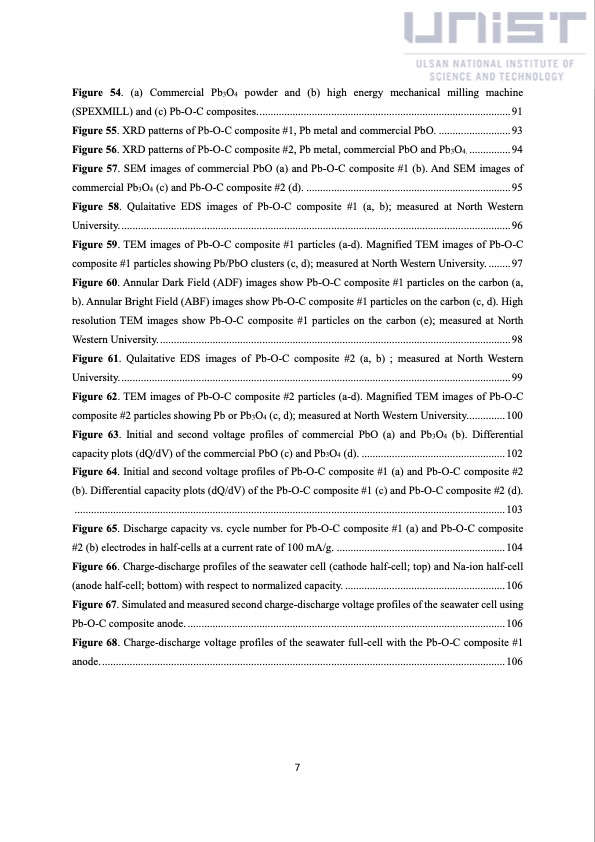
PDF Publication Title:
Text from PDF Page: 012
Figure 54. (a) Commercial Pb3O4 powder and (b) high energy mechanical milling machine (SPEXMILL) and (c) Pb-O-C composites............................................................................................91 Figure 55. XRD patterns of Pb-O-C composite #1, Pb metal and commercial PbO. .......................... 93 Figure 56. XRD patterns of Pb-O-C composite #2, Pb metal, commercial PbO and Pb3O4. ............... 94 Figure 57. SEM images of commercial PbO (a) and Pb-O-C composite #1 (b). And SEM images of commercial Pb3O4 (c) and Pb-O-C composite #2 (d). .......................................................................... 95 Figure 58. Qulaitative EDS images of Pb-O-C composite #1 (a, b); measured at North Western University. ............................................................................................................................................. 96 Figure 59. TEM images of Pb-O-C composite #1 particles (a-d). Magnified TEM images of Pb-O-C composite #1 particles showing Pb/PbO clusters (c, d); measured at North Western University. ........ 97 Figure 60. Annular Dark Field (ADF) images show Pb-O-C composite #1 particles on the carbon (a, b). Annular Bright Field (ABF) images show Pb-O-C composite #1 particles on the carbon (c, d). High resolution TEM images show Pb-O-C composite #1 particles on the carbon (e); measured at North Western University................................................................................................................................98 Figure 61. Qulaitative EDS images of Pb-O-C composite #2 (a, b) ; measured at North Western University. ............................................................................................................................................. 99 Figure 62. TEM images of Pb-O-C composite #2 particles (a-d). Magnified TEM images of Pb-O-C composite #2 particles showing Pb or Pb3O4 (c, d); measured at North Western University.............. 100 Figure 63. Initial and second voltage profiles of commercial PbO (a) and Pb3O4 (b). Differential capacity plots (dQ/dV) of the commercial PbO (c) and Pb3O4 (d). .................................................... 102 Figure 64. Initial and second voltage profiles of Pb-O-C composite #1 (a) and Pb-O-C composite #2 (b). Differential capacity plots (dQ/dV) of the Pb-O-C composite #1 (c) and Pb-O-C composite #2 (d). ............................................................................................................................................................ 103 Figure 65. Discharge capacity vs. cycle number for Pb-O-C composite #1 (a) and Pb-O-C composite #2 (b) electrodes in half-cells at a current rate of 100 mA/g. ............................................................. 104 Figure 66. Charge-discharge profiles of the seawater cell (cathode half-cell; top) and Na-ion half-cell (anode half-cell; bottom) with respect to normalized capacity. .......................................................... 106 Figure 67. Simulated and measured second charge-discharge voltage profiles of the seawater cell using Pb-O-C composite anode. ................................................................................................................... 106 Figure 68. Charge-discharge voltage profiles of the seawater full-cell with the Pb-O-C composite #1 anode. .................................................................................................................................................. 106 7PDF Image | China solar seawater battery

PDF Search Title:
China solar seawater batteryOriginal File Name Searched:
solar-seawater.pdfDIY PDF Search: Google It | Yahoo | Bing
Product and Development Focus for Salgenx
Redox Flow Battery Technology: With the advent of the new USA tax credits for producing and selling batteries ($35/kW) we are focussing on a simple flow battery using shipping containers as the modular electrolyte storage units with tax credits up to $140,000 per system. Our main focus is on the salt battery. This battery can be used for both thermal and electrical storage applications. We call it the Cogeneration Battery or Cogen Battery. One project is converting salt (brine) based water conditioners to simultaneously produce power. In addition, there are many opportunities to extract Lithium from brine (salt lakes, groundwater, and producer water).Salt water or brine are huge sources for lithium. Most of the worlds lithium is acquired from a brine source. It's even in seawater in a low concentration. Brine is also a byproduct of huge powerplants, which can now use that as an electrolyte and a huge flow battery (which allows storage at the source).We welcome any business and equipment inquiries, as well as licensing our flow battery manufacturing.| CONTACT TEL: 608-238-6001 Email: greg@salgenx.com | RSS | AMP |